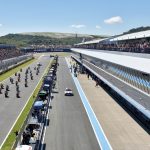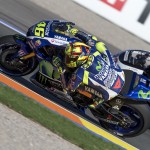Alex Hofmann is doing a good job as a host. A few half-decent jokes and some interesting questions to KTM CEO Stefan Pierer, Sports Director Pit Beirer and Dorna CEO Carmelo Ezpeleta – not forgetting figures like Vice President of Onroad Mike Leitner, principal test rider Mika Kallio (the Finn making the factory’s very first MotoGP appearance at Valencia in November) and technician Sebastian Risse (substituting for Chief Designer Kurt Trieb) – means the former racer and the very first rider to make laps in earnest on the sleek RC16 in 2015 is keeping a captive audience at Spielberg.
The unveiling of the bike itself is not a major deal; the RC16 is already familiar through its participation at the test around the same Austrian facility a few weeks before the Grand Prix. The Red Bull colours are prevalent in Moto3 and saturated in the Red Bull Rookies Cup and the MotoGP machine falls very much into line aesthetically. Risse is quick to claim however that the form of the present machine on stage could morph. “Sometimes the bike is changing, even day to day but the line is getting clearer,” he says. “It means in Valencia and Qatar you will not see the same bike, that’s for sure but I’m happy with the path it is on.”
RC16
Risse was coy on renowned journalist Mike Scott’s probes for the crank direction of the seamless shifting V4 powerplant that has already impressed the riders and other company on track. “It is a hot topic at the moment and we don’t want to reveal that information. We were doing some analysis and evaluations.”
“I had the feeling that the base is good and the lap-time was on a good level but we could improve things and went step by step,” reveals Kallio. “I think at Spielberg [test] it was nice to see that all the hard work people had done was on a high level. I don’t think there are any big things [needed to change] and we are close to our competitors and have to improve the parameters. The best point is the engine. It is very powerful. We need to improve a little bit the feeling of riding and turning in the corners and something on the exit but these are normal things for a new project. I would say that the engine is good on this bike and the rest is coming. Let’s see what happens in Valencia.”
There was also some explanation around the RC’s partial tubular chassis and how elements of Trieb’s first attempt at a MotoGP engine at the beginning of the century (KTM’s ill-fated bid to enter the class) transitioned into the new model. “The Chief Designer of that engine Kurt Trieb – in ‘02-‘03 – made the first version and it was powerful but some items were missing,” evaluates Pierer. “Kurt made his masterpiece and it will become a benchmark. He also did the Moto3 engine. Engine-wise we are very experienced and we know what we are doing. I am not over-confident [generally] but in that I am very confident. For sure there is some carry-over and the concept is a V4 but the angle is slightly different.”
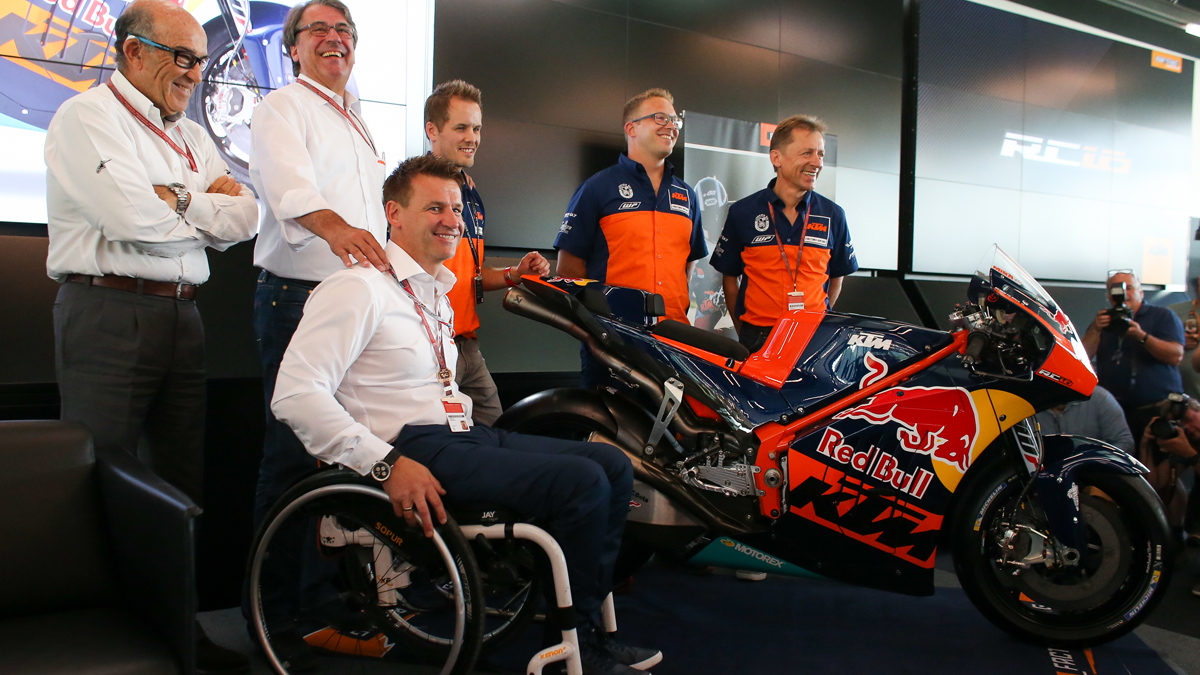
“The bike is completely new but the valve train worked well on the old engine so we took information over and saved some loops,” comments Risse. “We have been doing Superbike and Moto3 projects and Superbike is more applicable for the chassis while Moto3 is more for engine and all together brought this bike up.”
“We have a lot of experience with tubular frames and we can get an advantage from this,” he continues. “There is also the manufacturing and the design for manufacture because aluminium and steel both have different challenges. One thing that we learned in the past is that the steel frame is quick to modify and update and to make the loops in development a bit quicker than aluminium.”
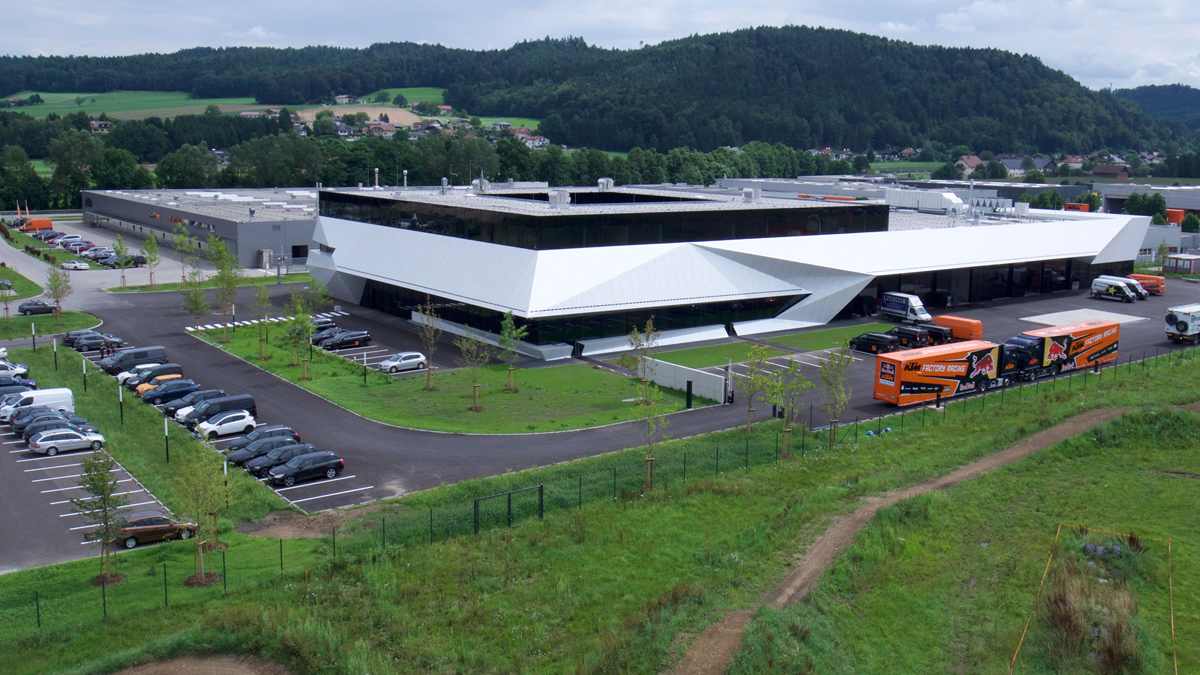
Origins
A week earlier, at the Swiss round of MXGP, we had already asked Pit Beirer about what the Red Bull Ring unveiling and explanation will mean to him. The German essentially had to create a entire MotoGP structure from a set of budget approval sheets and the movement even accelerated plans for a brand new workshop a few kilometres from Mattighofen in Munderfing. “For sure it will be an emotional moment because when you make the decision to start a project like this then you are in a small room with a couple of people,” he said at Frauenfeld. “If it is a motorsport subject then everybody looks at me and the question comes: “Pit, can we manage that or not?” For me it was a clear “yes” but then you start to have some sleepless nights! Seeing that we managed to have two complete crews and four bikes there ready to go and with lap-times that are quite promising and two good riders under contract and we show our race colours for the first time; it is an emotional and proud moment.”
“Almost two and a half years ago we made our decision – when we reached number one in Europe – to make the last step,” comments Pierer on the reasoning behind becoming the sixth factory in MotoGP. “We are the leading brand in off-road and fifteen years ago we decided to go on-road and now we are selling more than 60% of the 200,000 bikes on the street. To get accepted around the world then you need to enter MotoGP; the Formula 1 of motorcycle racing. It is the right time. Racing is our philosophy, our driving force and motivation. For sure we are making a learning curve when we go into a segment but we will reach the podium…and the dream of my life is to be world champion in MotoGP.”
“If you want to become a serious global player in the motorcycling industry then you have to be in the premier class that is MotoGP,” he adds. “It is not just marketing it also technology and what gets handed over to the production bike eventually. Competition is our primary force and it is what keeps you alive and what is driving more than five thousand people.”
“We are not famous for giving up. MotoGP is also a base to become number three in the world. This year we are reaching 200,000 and the goal then is 300,000. We are doing more than 50% of our sales outside of Europe; where we are number one. We are present everywhere.”
“We started to talk at the Grand Prix of Qatar in 2014 and we had a meeting with Pit Beirer asking to be the supplier of the Moto2 engine,” recounts Ezpeleta. “We explained that the place to be was in MotoGP and it was not difficult to convince them because the sprit of competition is in the heart of KTM. Now we have the balance between European and Japanese manufacturers and KTM have proved their sporting capabilities in all the other activities in which they take part. I am sure with the way they do things there will be a very big success and it will be an important step for us [MotoGP].”
“We have a professional testing structure so we have two crews ready to race already,” said Beirer, expanding on some of the specifics. “The race team is already in place and we could go testing consistently with two riders because we had enough bikes and material and good, strong engines that didn’t break so we could do laps, laps and laps and gather a lot. We went to many different kinds of tracks to get experience. We had smaller riders and taller riders and many things. Qatar is just around the corner: Valencia is our wild-card GP and we have four more tests in place. From our tests at Spielberg we could see that we are not too far away. We have a good time schedule so no need for a crazy panic but Qatar is our goal and to be ready for there and we are on schedule.”
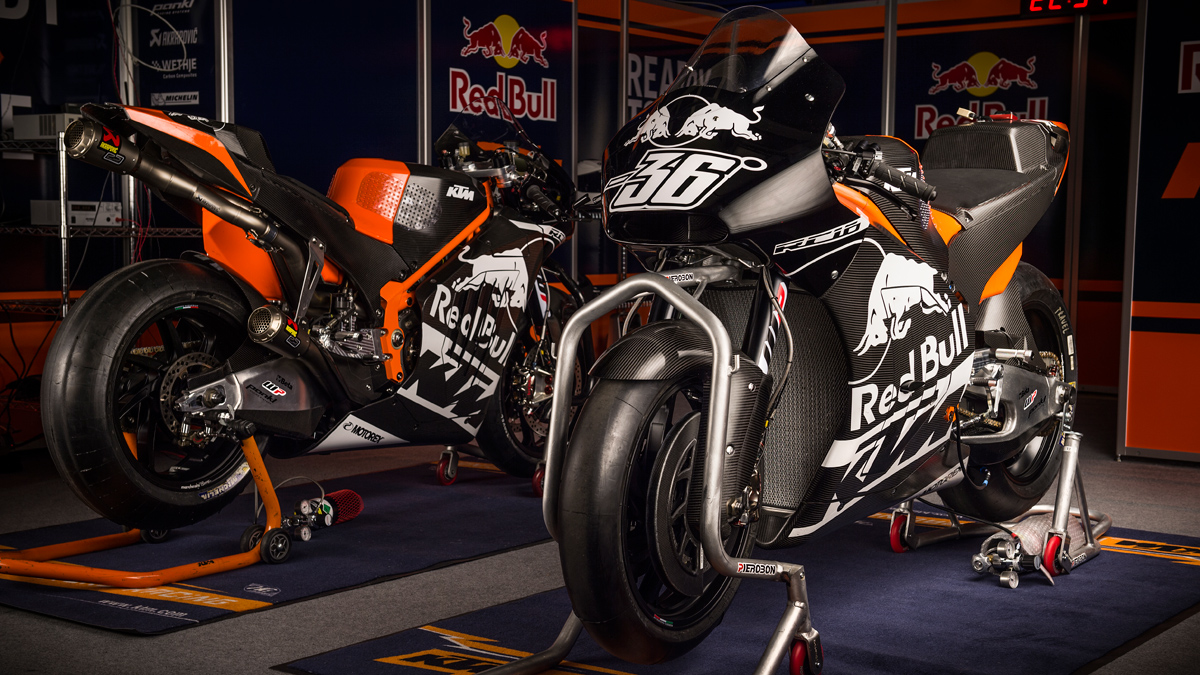
The Path
With a pyramid now in road racing with the RC390 Cup, the youth of the Red Bull Rookies on RC250s, Aki Ajo bringing success and prestige in Moto3, a WP/KTM chassis collusion for Moto2 from 2017 (with competitive times set already in tests from Ricky Cardus and Julian Simon at the bars) and now MotoGP, KTM are laying down a potent path in the discipline.
“We hate to ‘lose’ riders for whatever reason,” says Beirer. “We’ve had the Rookies Cup for ten years now and together with Red Bull have produced many fantastic riders for the paddock. For us the line finished in Moto3 and it was so hard to let some of the kids go, so we decided for a Moto2 project to go in the gap and I have to thank Aki for the fantastic job he does for us. Our dream is that one day we start with a kid in the Rookies Cup and then up to the MotoGP bike.”
“At the beginning I was unsold on Moto2 but I can see how it is important for development of GP riders and so it is another cost control,” said the ever-frank Pierer. “It is cheaper than Moto3 I can tell you! As a manufacturer I don’t have a problem with the engine and if another competitor is in. You can see the difference in chassis and setting. I’m in favour of Moto2 but not in favour of presenting an engine [in the future]. Even though we are a successful company we are also a small one compared to our competitors.”
Before group photos wound-up proceedings (until the bikes made a few demo laps before the MotoGP race on Sunday) there was the question of whether the RC16 would ever spawn a road going version. The days of the iconic RC8 and KTM’s first Superbike seem to be numbered…don’t expect an update any time soon. “There is no plan to build a Superbike again,” says Pierer. “A bike like the RC16 with 270 horses should go closed-course. We will offer a replica [of the RC16] very soon at a feasible price for the KTM customer to have a real race feeling but such a bike I think is not right for the road. Safety is one of the biggest threats and issues in the motorcycle industry and as a manufacturer we have to take it very seriously.”
And the rest?
Ever since KTM announced their dabble with MotoGP, and even back to their foray in Moto3 in 2011 where they won the at the first try and have owned two of the four crowns so far, there has been scepticism about the spread of their resources for racing. Amazing success in motocross, supercross, enduro and rally has gone hand-in-hand with exponential growth in sales and model development and KTM are allegedly set for a bumper 2017 in terms of machine releases. The 300k barrier is firmly in sight but will it come at a cost? Will the orange wilt in classes where they have made such a mark? Pierer was quick to reassure.
“That was the concern of our customers fifteen years ago; that we are going on-road and leaving our off-road roots,” he said. “In specific classes it takes a very long time to be successful. In Dakar we started almost twenty years ago and for the last fifteen years we are dominating: we don’t leave that because it is very important. It took more than a decade to become Supercross champion in the States and we will do it in the same style here. We won’t give up.”
The words and feelings of determination seem to accompany the pride on display for KTM at Spielberg and Pierer was visibly moved as he sat next to the RC16. Although they were not present (naturally) the wave of optimism can only be encouraging for Bradley Smith and Pol Espargaro who will only have to wait until the Monday after Valencia for their turn to blip the throttle on the Austrian’s freshest adventure.
Photos by CormacGP/KTM

